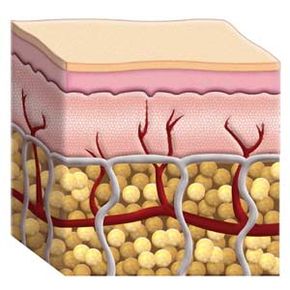The layered look is definitely "in" when it comes to your skin. Like a tank top, followed by a blouse and topped off with a sweater to create a complete ensemble, your skin has three layers that each serves an important purpose. Though you cannot see it, the innermost layer -- the tank top, if you will -- is composed of subcutaneous tissue, an all-important insulator that regulates your body's temperature and protects your insides.
It's difficult to appreciate the subcutaneous tissue, also called the hypodermis, without considering the skin's other two layers, the epidermis and dermis. The epidermis is the outer layer that encases your entire body [source: American Medical Association]. Though it might look thin and flimsy, the epidermis is tough as nails when it comes to protecting you from bacteria and environmental toxins. It also holds a whole lot of water and is responsible for that healthy glow -- or lack thereof [source: WebMD]. In addition, this very useful layer gives skin its color.
Advertisement
Under the epidermis lies the dermis. Among other things, the dermis is responsible for your skin's strength and elasticity, thanks to the collagen and elastin fibers it contains [source: WebMD]. Nerves in the dermis allow you to feel the gentlest touch and the deepest pain. You'll also find glands and hair follicles in the dermis.
And now to the subcutaneous tissue -- it is an important (although often unappreciated) line of defense in your body. Subcutaneous tissue is composed of an insulating layer of fat and blood vessels [source: WebMD]. Though many people aren't particularly grateful for the fat in their bodies, the fat in the subcutaneous layer would likely be missed if it were to disappear, considering that it protects the organs and bones and keeps the body's temperature where it ought to be.
There's much to love about the subcutaneous tissue. Keep reading to find out everything this "tank top layer" does for you.
Advertisement


